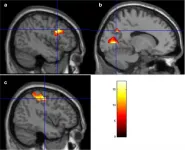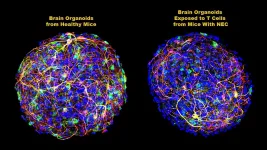Light-based processors boost machine-learning processing
2021-01-06
(Press-News.org) The exponential growth of data traffic in our digital age poses some real challenges on processing power. And with the advent of machine learning and AI in, for example, self-driving vehicles and speech recognition, the upward trend is set to continue. All this places a heavy burden on the ability of current computer processors to keep up with demand.
Now, an international team of scientists has turned to light to tackle the problem. The researchers developed a new approach and architecture that combines processing and data storage onto a single chip by using light-based, or "photonic" processors, which are shown to surpass conventional electronic chips by processing information much more rapidly and in parallel.
The scientists developed a hardware accelerator for so-called matrix-vector multiplications, which are the backbone of neural networks (algorithms that simulate the human brain), which themselves are used for machine-learning algorithms. Since different light wavelengths (colors) don't interfere with each other, the researchers could use multiple wavelengths of light for parallel calculations. But to do this, they used another innovative technology, developed at EPFL, a chip-based "frequency comb", as a light source.
"Our study is the first to apply frequency combs in the field of artificially neural networks," says Professor Tobias Kippenberg at EPFL, one the study's leads. Professor Kippenberg's research has pioneered the development of frequency combs. "The frequency comb provides a variety of optical wavelengths that are processed independently of one another in the same photonic chip."
"Light-based processors for speeding up tasks in the field of machine learning enable complex mathematical tasks to be processed at high speeds and throughputs," says senior co-author Wolfram Pernice at Münster University, one of the professors who led the research. "This is much faster than conventional chips which rely on electronic data transfer, such as graphic cards or specialized hardware like TPU's (Tensor Processing Unit)."
After designing and fabricating the photonic chips, the researchers tested them on a neural network that recognizes of hand-written numbers. Inspired by biology, these networks are a concept in the field of machine learning and are used primarily in the processing of image or audio data. "The convolution operation between input data and one or more filters - which can identify edges in an image, for example, are well suited to our matrix architecture," says Johannes Feldmann, now based at the University of Oxford Department of Materials. Nathan Youngblood (Oxford University) adds: "Exploiting wavelength multiplexing permits higher data rates and computing densities, i.e. operations per area of processer, not previously attained."
"This work is a real showcase of European collaborative research," says David Wright at the University of Exeter, who leads the EU project FunComp, which funded the work. "Whilst every research group involved is world-leading in their own way, it was bringing all these parts together that made this work truly possible."
The study is published in Nature this week, and has far-reaching applications: higher simultaneous (and energy-saving) processing of data in artificial intelligence, larger neural networks for more accurate forecasts and more precise data analysis, large amounts of clinical data for diagnoses, enhancing rapid evaluation of sensor data in self-driving vehicles, and expanding cloud computing infrastructures with more storage space, computing power, and applications software.
INFORMATION:
Reference
J. Feldmann, N. Youngblood, M. Karpov, H. Gehring, X. Li, M. Stappers, M. Le Gallo, X. Fu, A. Lukashchuk, A.S. Raja, J. Liu, C.D. Wright, A. Sebastian, T.J. Kippenberg, W.H.P. Pernice, H. Bhaskaran. Parallel convolution processing using an integrated photonic tensor core. Nature 07 January 2021. DOI: 10.1038/s41586-020-03070-1
[Attachments] See images for this press release:

ELSE PRESS RELEASES FROM THIS DATE:
2021-01-06
A study led by University of Ottawa researchers provides empirical evidence that mindfulness has a significant impact on the brain of women suffering from neuropathic pain related to breast cancer treatment. The researchers showed that mindfulness-based stress reduction (MBSR) helps modulate neuropathic pain.
Their findings could make a difference in the lives of many women. In Canada, over a quarter of a million women are expected to be diagnosed with breast cancer - the most diagnosed cancer among women worldwide - in 2020. In addition to the psychological impacts of breast cancer, approximately 20 to 50 percent of survivors report experiencing chronic neuropathic pain following treatment.
We talked to senior author Dr. Andra Smith, Full Professor at the uOttawa School of Psychology, ...
2021-01-06
Physicians have long known that necrotizing enterocolitis (NEC), a potentially lethal inflammatory condition that destroys a premature infant's intestinal lining, is often connected to the development of severe brain injury in those infants who survive. However, the means by which the diseased intestine "communicates" its devastation to the newborn brain has remained largely unknown.
Now, working with mice, researchers at Johns Hopkins Medicine and the University of Lausanne in Switzerland have identified that missing link -- an immune system cell that they say travels from the gut to the ...
2021-01-06
Indianapolis, Ind. - A team of researchers led by the Indiana Biosciences Research Institute Diabetes Center's Scientific Director Decio L. Eizirik, MD, PhD, has found that identifying new treatments for autoimmune diseases requires studying together the immune system AND target tissues. This study, "Gene expression signatures of target tissues in type 1 diabetes, lupus erythematosus, multiple sclerosis and rheumatoid arthritis," is featured in the Jan. 6, 2021, edition of Science Advances.
"We must move away from the present "immune-centric-only" view of autoimmune diseases," explains Eizirik. "Indeed, trying to understand these diseases focusing on the immune system only, ...
2021-01-06
Researchers at Rush University Medical Center have found that opioid use might increase a person's risk of developing pancreatic cancer.
Published Jan. 6, the study, titled "Opioid Use as a Potential Risk Factor for Pancreatic Cancer in the United States," is the first in the country to show evidence that opioid use may be an unidentified risk factor contributing to the increasing incidence of pancreatic cancer.
In fact, opioid misuse and overdose have evolved into a public health crisis. Approximately 70,000 drug overdose deaths were reported in 2017, 68% of which involved an opioid.¹ The use of prescription opioids for the management of chronic pain ...
2021-01-06
DURHAM, N.C. -- Before the pandemic, one-third of U.S. households with children were already "net worth poor," lacking enough financial resources to sustain their families for three months at a poverty level, finds new research from Duke University.
In 2019, 57 percent of Black families and 50 percent of Latino families with children were poor in terms of net worth. By comparison, the rate for white families was 24 percent.
"These 'net worth poor' households have no assets to withstand a sudden economic loss, like we have seen with COVID-19," said Christina Gibson-Davis, co-author of the study and professor of public policy and sociology at Duke University's Center for Child and Family Policy. "Their ...
2021-01-06
Related to new research published in the January issue of Science Translational Medicine, Patrick McNutt, PhD, of the Wake Forest Institute for Regenerative Medicine, was part of the research team that demonstrated a new "Trojan horse" approach that produces strong antidotal efficacy in treating lethal botulism in mice, guinea pigs and rhesus macaque monkeys.
Furthermore, in a companion article, an independent team demonstrated that a related drug has robust efficacy in mice.
"This is one of those serendipitous moments in science where two groups, working independently, demonstrate similar results for a long-standing ...
2021-01-06
Investing in biotech companies may not entail higher risk than investing in other sectors, according to a new report from Bentley University's Center for Integration of Science and Industry. A large scale study of biotechnology companies that completed Initial Public Offerings (IPOs) from 1997-2016 demonstrates that these companies produced more than $100 billion in shareholder value and almost $100 billion in new value creation despite a failure rate greater than 50%. The study compared the financial performance and economic value created by these biotech companies to non-biotechnology controls that had similarly timed IPOs.
The findings are published in PLOS ONE in the article "Comparing long-term value creation after biotech and non-biotech ...
2021-01-06
Our reluctance to think, talk or communicate about death is even more pronounced when we deal with others' loss compared to our own, new research finds, but either way we tend to frame attitudes and emotions in a sad and negative way.
Teaching new more positive ways to address these difficult conversations is the focus of a new paper in PLOS ONE journal by palliative care specialists across Australia.
Led by Flinders University's Research Centre for Palliative Care, Death and Dying (RePaDD) and Palliative and Supportive Services, researchers from Flinders, CQUniversity Australia, NT Palliative Care Central Australia and University of Technology Sydney, surveyed 1,491 people about ...
2021-01-06
Photosynthetic organisms tap light for fuel, but sometimes there's too much of a good thing.
New research from Washington University in St. Louis reveals the core structure of the light-harvesting antenna of cyanobacteria or blue-green algae -- including key features that both collect energy and block excess light absorption. The study, published Jan. 6 in Science Advances, yields insights relevant to future energy applications.
Scientists built a model of the large protein complex called phycobilisome that collects and transmits light energy. Phycobilisomes allow cyanobacteria to take advantage of different wavelengths of light than other photosynthetic ...
2021-01-06
An analysis of 145 scholarly journals found that, among various factors that could contribute to gender bias and lesser representation of women in science, the peer review process itself is unlikely to be the primary cause of publishing inequalities. However, Flaminio Squazzoni and colleagues emphasize that the study does not account for many other factors that may affect women's representation in academia, including educational stereotypes and academic choices of priorities and specialties. Even as female representation has improved in fields such as the humanities, psychology, and the social sciences, a publication gap persists, with male authors continuing to publish more manuscripts in more prestigious journals. To better understand whether ...
LAST 30 PRESS RELEASES:
[Press-News.org] Light-based processors boost machine-learning processing






